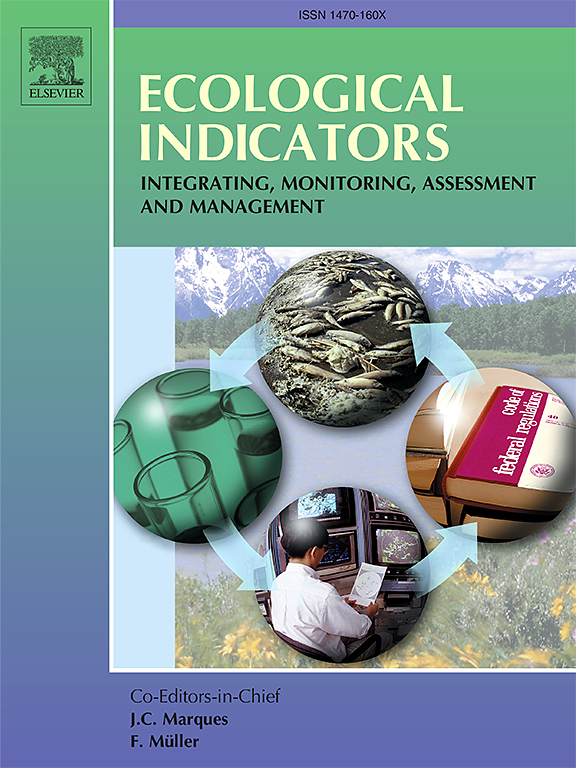青藏高原东部4种地下苔藓植物叶片大小变化及其环境驱动因素
IF 7
2区 环境科学与生态学
Q1 ENVIRONMENTAL SCIENCES
引用次数: 0
摘要
叶片大小的变化及其对环境变量的响应将提高我们对不同物种如何适应区域气候变化的理解。在温带和北方针叶林中,苔藓植物通常是主要的地表覆盖,可以作为森林类型的指示物。然而,苔藓植物的种间和种内叶片大小的变化及其与环境变量的关系仍然知之甚少。在青藏高原东部的森林中,我们采集了4种地下苔藓植物Abietinella abietina、Rhytidium rugosum、Thuidium asquium和T. cymbifolium,测量了每个物种的叶长(LL)、叶宽(LW)和叶面积(LA),并估算了种间(BTV)、种内性状变异(ITV)和环境因子对总性状变异的相对量。采用层次划分分析评价了环境因子对各树种叶片大小变化的个体影响。利用简单的线性模型分析了性状与环境的关系。LA、LL和LW的变异系数分别为18.29% ~ 64.04%、11.42% ~ 37.91%和11.71% ~ 36.44%。对3个叶片大小性状,BTV大于ITV,气候比土壤和微生境具有更强的解释力。冷杉叶片大小主要受气候影响,与温度季节性呈正相关。荆芥和荆芥叶片大小受土壤控制,随土壤有机碳的增加而增大。苔藓覆盖决定了春兰叶片的大小,二者呈正相关。结果表明,在全球变暖的影响下,三种植物的叶片都有变小的趋势。这些发现为苔藓植物叶片大小的变化提供了有价值的证据,并为植物对全球气候变化的响应提供了新的见解。本文章由计算机程序翻译,如有差异,请以英文原文为准。
Leaf size variations in four ground-floor bryophytes and their environmental drivers across the forests of the eastern Qinghai-Tibet Plateau
Variations in leaf size and its responses to environmental variables will improve our understanding of how different species adapt to regional climate changes. Bryophytes usually form dominant ground-floor cover in temperate and boreal forests and could be used as indicators of the forest types. However, interspecific and intraspecific variations in leaf size of bryophytes and their relationships with environmental variables remain poorly understood. We sampled four ground-floor bryophytes, i.e., Abietinella abietina, Rhytidium rugosum, Thuidium assimile, and T. cymbifolium, across the forests of the eastern Qinghai-Tibet Plateau (QTP), measured the leaf length (LL), leaf width (LW), and leaf area (LA) of each species, and estimated the relative amounts of interspecific (BTV), intraspecific trait variation (ITV), and environmental factors to the total trait variance. Hierarchical partitioning analysis was used to evaluate the individual effects of environmental factors on leaf size variations in each species. The trait-environment relationships were analyzed using a simple linear model. The coefficient of variation of LA, LL, and LW ranged from 18.29% to 64.04%, from 11.42% to 37.91%, and from 11.71% to 36.44%, respectively. For the three leaf size traits, BTV was greater than ITV and climate had stronger explanatory power than soil and microhabitat. The leaf size of A. abietina was primarily dominated by climate and positively correlated with temperature seasonality. The leaf size of R. rugosum and T. assimile were controlled by soil and increased with the increasing soil organic carbon. Bryophyte cover determined the leaf size of T. cymbifolium and they were positively related. The results suggested that the leaf size of three species would tend to be smaller under global warming of the QTP. The findings provided valuable evidence in variations of bryophyte leaf size and new insights into the plants’ responses to global climate change.
求助全文
通过发布文献求助,成功后即可免费获取论文全文。
去求助
来源期刊

Ecological Indicators
环境科学-环境科学
CiteScore
11.80
自引率
8.70%
发文量
1163
审稿时长
78 days
期刊介绍:
The ultimate aim of Ecological Indicators is to integrate the monitoring and assessment of ecological and environmental indicators with management practices. The journal provides a forum for the discussion of the applied scientific development and review of traditional indicator approaches as well as for theoretical, modelling and quantitative applications such as index development. Research into the following areas will be published.
• All aspects of ecological and environmental indicators and indices.
• New indicators, and new approaches and methods for indicator development, testing and use.
• Development and modelling of indices, e.g. application of indicator suites across multiple scales and resources.
• Analysis and research of resource, system- and scale-specific indicators.
• Methods for integration of social and other valuation metrics for the production of scientifically rigorous and politically-relevant assessments using indicator-based monitoring and assessment programs.
• How research indicators can be transformed into direct application for management purposes.
• Broader assessment objectives and methods, e.g. biodiversity, biological integrity, and sustainability, through the use of indicators.
• Resource-specific indicators such as landscape, agroecosystems, forests, wetlands, etc.
 求助内容:
求助内容: 应助结果提醒方式:
应助结果提醒方式:


